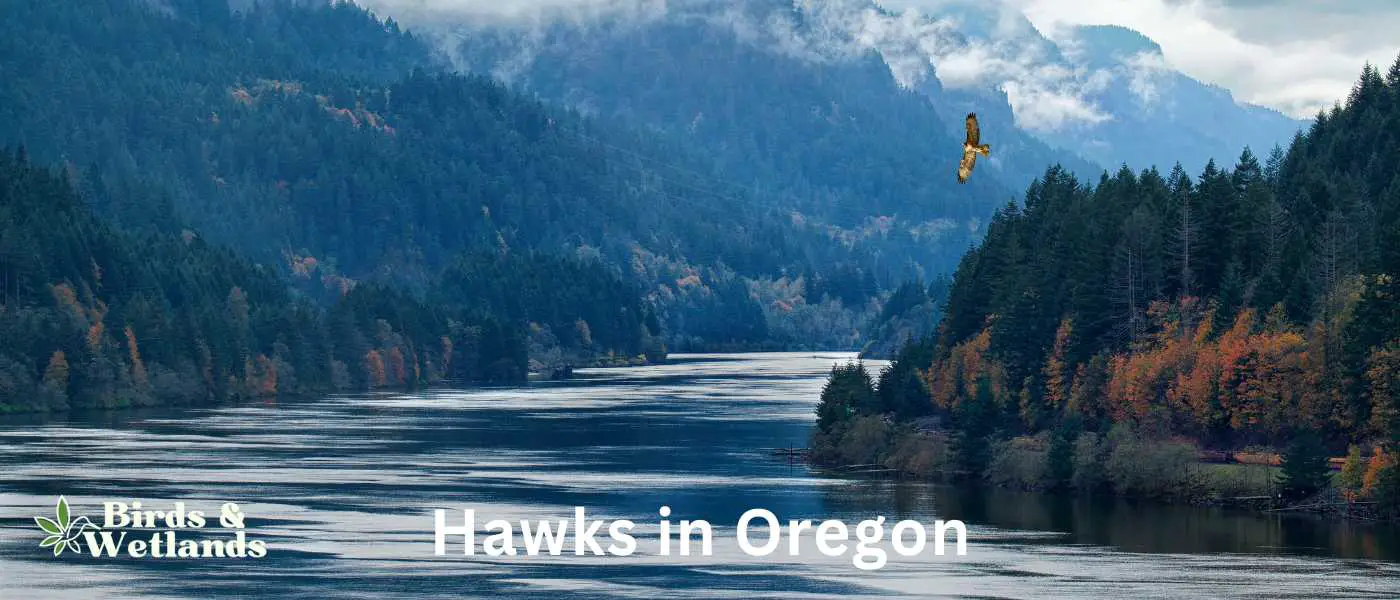From the rugged Pacific coastline to the high desert and lush forests, Oregon’s varied landscapes serve as a vibrant stage for a host of captivating hawks. Known for their powerful flight and precise hunting skills, these raptors enhance the state’s rich biodiversity and provide a fascinating spectacle for birdwatchers and nature lovers alike.
As we explore Oregon’s skies, we’ll uncover the intriguing behaviors and adaptations that make these hawks truly spectacular.
Types of Hawk in Oregon
Red-tailed Hawks: Commonly seen soaring over the wide open spaces of Eastern Oregon’s high desert, they are also often sighted in the Columbia River Gorge area.
Northern Harrier: Frequents the vast wetlands of the Malheur National Wildlife Refuge, where their distinctive, low gliding flight is a common sight.
Cooper’s Hawks: Primarily a bird of the deciduous forests, these hawks can be often seen in areas like the Mount Hood National Forest.
Sharp-shinned Hawks: Known to inhabit mixed woods, this hawk is a common sight in the Rogue River-Siskiyou National Forest located in southwestern Oregon.
Rough-legged Hawks: Prefers open country and can be often seen during winter months in the agricultural lands of the Willamette Valley.
Red-shouldered Hawks: A year-round resident in the southwest corner of the state, especially near the Smith River area.
Swainson’s Hawks: An inhabitant of open country, often seen during the summer months in the semi-arid regions of Central Oregon, such as near the city of Bend.
Northern Goshawks: Prefers mature, dense forests and can be commonly spotted in the Siuslaw National Forest.
Ferruginous Hawks: Known to frequent the open grasslands of Eastern Oregon, specifically near the city of Burns.
Broad-winged Hawks: Though not as common as others, they can occasionally be sighted during migration season over the Klamath Basin.
Zone-tailed Hawks: This elusive and rare hawk has been sighted only a few times, mainly in the southeast region near the Steens Mountain Wilderness. Their sightings, although extremely rare, generate much excitement among Oregon’s birdwatchers.
Oregon Hawks Photo Guide
Red-tailed Hawk (Buteo jamaicensis)

The Red-tailed Hawk is a large bird of prey that is commonly found across North America. This species is part of the genus Buteo, which is often referred to as the “true hawks,” and includes more than two dozen species of raptors.
Red-tailed Hawks have a robust size, ranging from 18 to 26 inches in length and sporting a wingspan that can exceed 4 feet. They have a broad, rounded set of wings and a short, wide red tail. This species is most easily recognized by its rich, rust-colored tail, which gives it its common name. However, juvenile hawks might not yet have this distinctive feature.
Their feathers are generally dark brown on their dorsal side (back) with a lighter, often speckled, ventral side (front). The intensity and pattern of their plumage can vary significantly based on their age and geographic location, as there are about 14 recognized subspecies of Red-tailed Hawks.
As for their diet, Red-tailed Hawks are carnivores and have a broad diet that includes rodents, ground rabbits, reptiles, and other birds. They are skilled hunters that typically sit on high perches and use their keen eyesight to spot potential prey. Once they have identified a target, they swoop down to capture it with their powerful talons.
Red-tailed Hawks mate for life and build nests high off the ground, often in tall trees or on cliff edges. Their nests are made of sticks and can be quite large. They typically lay 1-3 eggs per year, which are incubated by both parents.
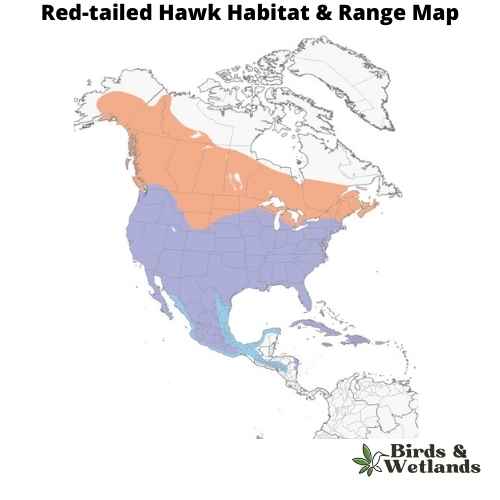
Red-tailed Hawk Sound
Northern Harrier (Circus hudsonius)

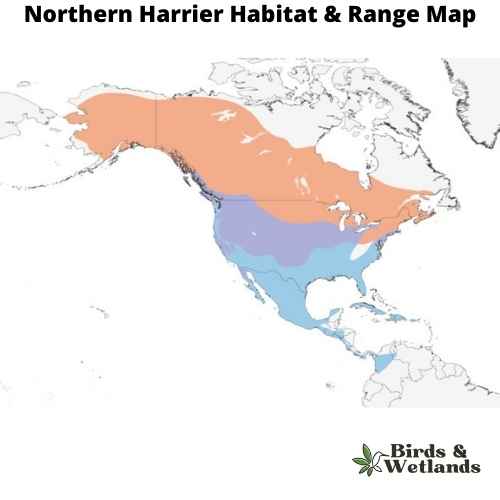
Listen:
The Northern Harrier is a medium-sized, slender hawk.
Adult birds are gray above, with pale bars on the wing feathers and white markings on the underwings and a white rump patch. The breast is barred with black and white, and the belly is streaked with brown.
They prefer open areas, such as grasslands and marshes, but can be found in almost any open habitat except dense woods.
Northern Harriers are opportunistic hunters that feed on small mammals such as mice, voles and rabbits as well as birds including quail, grouse and ducks. They hunt by flying low over open spaces such as fields or marshes.
Northern harrier nests on the ground in lowlands or hillsides near water bodies. It lays two to four eggs which hatch after 24 days of incubation by both parents. The chicks fledge after 30 days of hatching and remain dependent on their parents for another three weeks during which they learn how to fly.
Cooper’s Hawk (Accipiter cooperii)

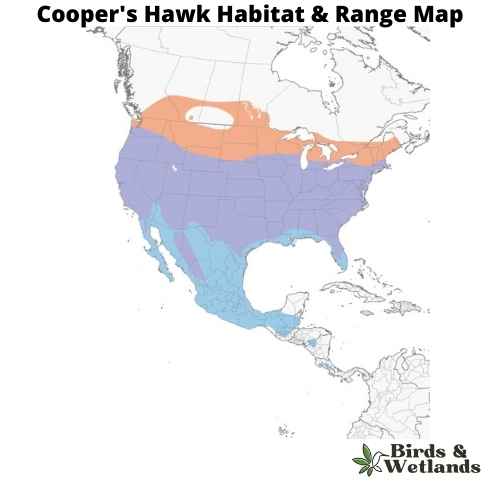
Listen:
The Cooper’s Hawk is a medium-sized bird of prey native to North America. Known for its agility and speed, it is part of the Accipitridae hawk species, which also includes other hawks, eagles, and kites.
Cooper’s Hawks are typically about 14 to 20 inches in length, with a wingspan ranging from 27 to 36 inches. They are known for their distinctive long, rounded tails and short, rounded wings. They have a steely blue gray top, with rusty bars on their underparts and thick, dark bands on their tails.
The Cooper’s Hawk is a skilled predator, primarily hunting birds and small mammals. They are adept at hunting in both dense forests and open areas, often catching prey mid-air in high-speed pursuits. They have also been known to visit the backyard bird feeder, not for the seed, but to prey on the smaller birds that gather there.
Cooper’s Hawks often build nests in dense tree canopies where they are well concealed. The female usually lays 3 to 5 eggs, and both parents share incubation duties. The young hawks fledge after about a month but will stay close to the nest, relying on their parents for food as they learn to hunt.
Sharp-shinned Hawk (Accipiter striatus)

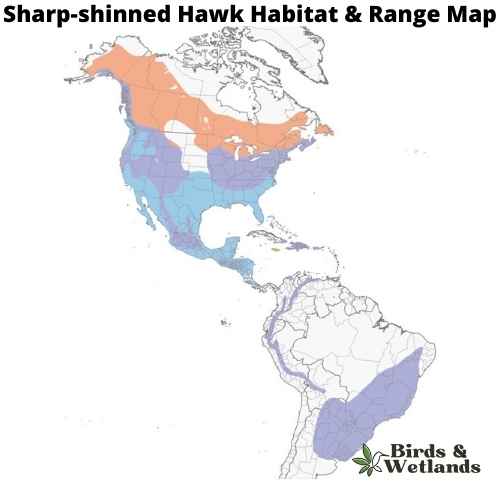
Listen:
The adult bird is brown on top and white underneath, with a dark brown band across its chest. It has short, rounded wings and a long tail that makes it look larger than it actually is. Adult sharp shinned hawks have black eyes, which are surrounded by white feathers. The female Sharp-shinned Hawk is browner than the male, who has darker brown markings on his back.
Sharp-shinned Hawks prefer open country for their habitat, including fields and meadows where they can hunt for mice and other small animals. They can be found throughout the United States but are most common in the east.
Sharp-shinned Hawks eat mostly small birds, such as sparrows and warblers, as well as small mammals such as mice and gophers. They catch prey by surprise using their incredible speed and agility, diving out of the sky at speeds up to 200 mph.
Sharp-shinned Hawks have an unusual hunting style for hawks—they prefer to catch their prey from perches above trees or telephone wires, rather than swooping down from above like most other hawks do and can often be seen hunting near bird feeders.
Rough-legged Hawk (Buteo lagopus)

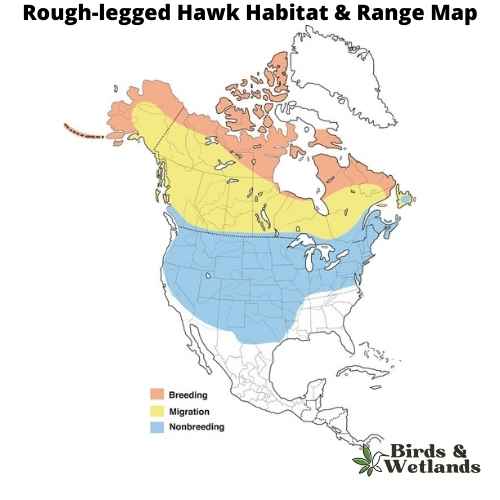
Rough-legged Hawk Sound
The Rough-legged Hawk is a large, raptor that is native to North America. It is also known as the American Rough-legged Hawk. Scientific Name: Buteo lagopus
The Rough-legged Hawk is a medium-sized hawk with a distinctive appearance, with dark brown feathers on its back and light brown feathers on its underside and broad thin wings. The hawk’s legs are also covered in dark feathers, which help to distinguish it from other species of hawk. The tail is barred with black and white. They have yellow eyes and dark feet.
Rough-legged Hawks hunt from above ground level, swooping down to catch its prey in its talons. When hunting for food, they prefer to eat small mammals such as squirrels and rabbits but will also eat birds if there aren’t any small mammals available. Although they eat a variety of small animals including birds, rodents, bats and reptiles, they rely heavily on fish for food during breeding season because it provides them with protein and calcium needed to produce eggs.
Red-shouldered Hawk (Buteo lineatus)

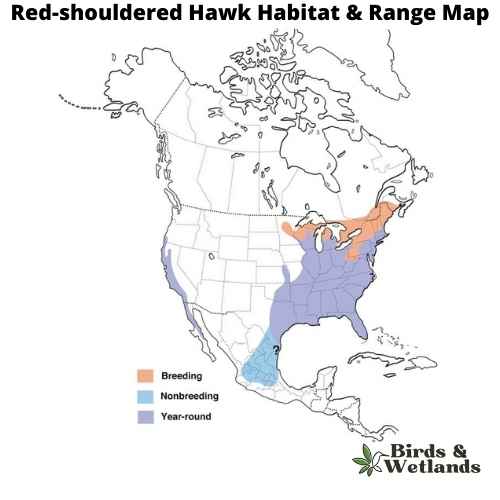
Listen:
The red-shouldered hawk are medium sized birds of prey, part of the buteo hawks family. It can be distinguished from other hawks by its reddish iris and pale legs.
The adult has rusty red upperparts, white underparts, a black chin and throat, and a reddish brown stripe over each eye, reddish brown heads and a strongly banded tail. The tail is reddish brown with two paler bands across it and they have white checkered wings. Juveniles are brown with dark barring and have pale fringes on the feathers of their wings.
Red-shouldered hawks nest in trees, though they also inhabit manmade structures including barns, bridges, and buildings. They prefer wooded areas with an open canopy but will use other places as well for nesting such as shrubs and hedges if needed.
The red-shouldered hawk’s diet – they eat small mammals such as ground squirrels, rabbits, voles, mice and rats. They also eat birds such as quail, pigeons and doves; reptiles including snakes; amphibians; fish; crustaceans; insects; and carrion (dead animals).
Swainson’s Hawk (Buteo swainsoni)
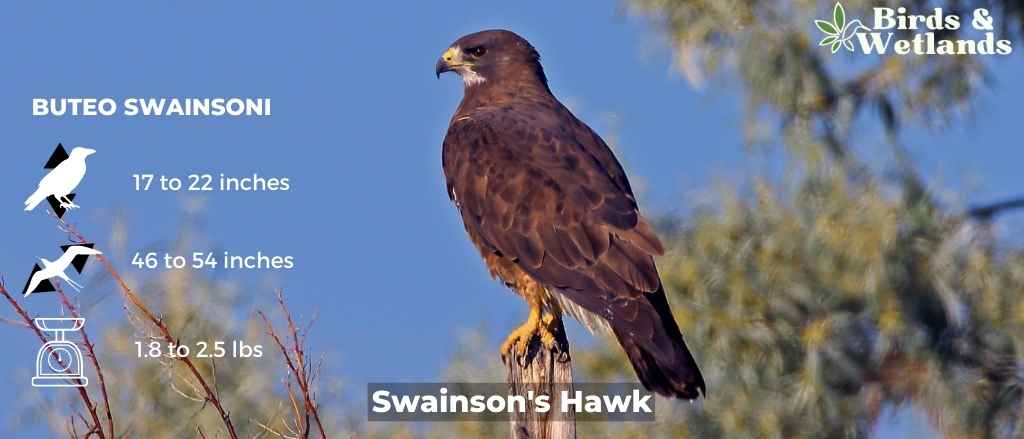
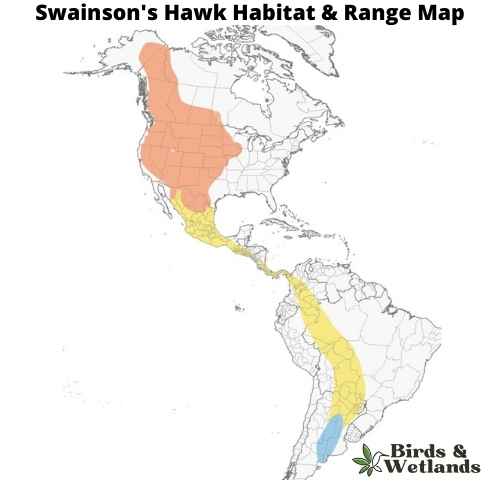
Listen: Swainson’s Hawk
Swainson’s Hawk is a medium-sized hawk that is found in North America and South America, Scientific Name: Buteo swainsoni.
The bird has a blue-gray plumage with a dark brown back, wings, and tail. It also has a white chest and belly. The beak and feet are black, but the eyes are yellow. They are often confused with Cooper’s Hawk because of similar coloring, but Swainson’s Hawks have wider tails and longer wings than their cousin species.
These birds eat small rodents such as gophers and mice. They also eat insects like grasshoppers and crickets during the summer months when they’re plentiful. They sometimes steal prey from other birds of prey such as Northern Harriers who hunt the same prey.
Swainson’s Hawks build nests on rocky cliffs near water sources where they can find food easily. They lay three to five eggs that hatch after about two months into fluffy brown baby hawks who leave the nest after about three weeks (or when they’re big enough).
Northern Goshawk (Accipiter gentilis)


Listen:
The Northern Goshawk is a medium-sized hawk that is found in North America, Europe and Asia. It has brown eyes, a large sharp beak, and dark brown plumage on its upperparts and head, with white underparts that are spotted with brown barring. Its tail feathers are grayish-black with a dark band near the tip.
Northern goshawks eat squirrels, rabbits, grouse, woodchucks and other small mammals like voles or mice (which they often eat whole). They will also take larger prey such as deer fawns or even adult deer if they have no other choice. They have broad wings with long feathers that allow them to glide through the air when they catch their prey. They also have an excellent sense of smell which helps them locate their food source.
The Northern Goshawk builds its nest in a tree cavity or on a ledge, usually on the edge of an open area so it can easily see prey below. The female lays 3 to 5 eggs over two days and incubates them for 28 to 30 days while the male brings food to her every few hours until they hatch. The young fledge after about 6 weeks and leave the nest when they are about 10 weeks old.
Ferruginous Hawk (Buteo regalis)

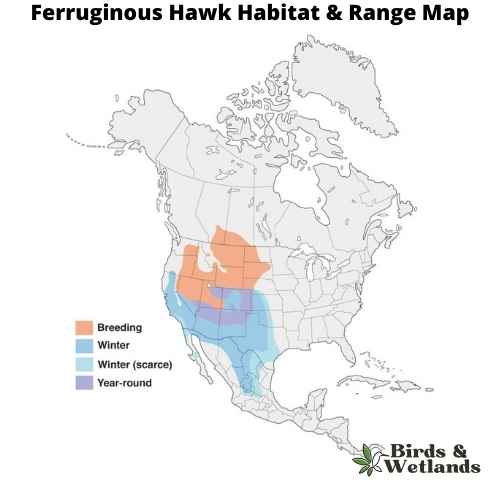
Ferruginous Hawk Sound
Scientific Name: Buteo regalis
Length: 20 to 27 in
Wingspan: 48 to 60 in
Weight: 32.0 to 80.0 oz
The Ferruginous Hawkis the largest hawk species native to North America. Known for its distinctive coloration and impressive size, this bird of prey predominantly inhabits the open landscapes of the western United States and parts of Canada.
Ferruginous Hawks are notable for their “ferruginous” or rust-colored back and shoulders, which contrasts sharply with the bird’s white underside. The hawk also has broad, rounded wings and a large, gape-mouthed beak. Ferruginous hawks exhibit dark morph and light morphs. Dark morphs have dark brown plumage, while light morphs display lighter, reddish-brown plumage. Morphs vary geographically.
Primarily feeding on small to medium sized mammals like rabbits and prairie dogs, the Ferruginous Hawk is an agile hunter, often seen soaring high above the ground or perched prominently while scanning for prey. It occasionally feeds on birds, reptiles, and insects as well.
Nesting for Ferruginous Hawks typically occurs on cliffs, hillsides, or large trees. The female lays between 2 to 5 eggs, and both parents share in the incubation and rearing of the chicks. The Ferruginous Hawk is a relatively solitary bird outside of the breeding season, and its call is a loud, high-pitched scream, often heard during courtship or near the nest.
Broad-winged Hawk (Buteo platypterus)

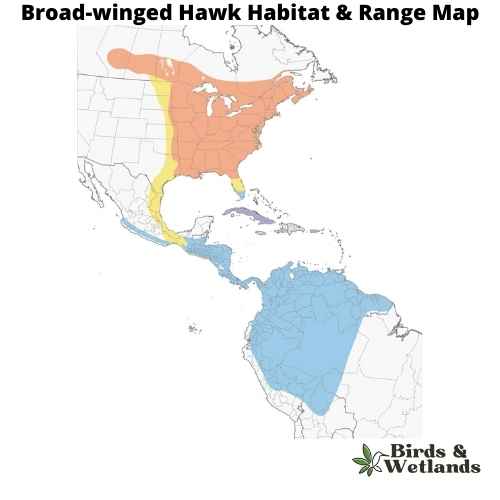
Broad-winged Hawk Sound
The Broad-winged Hawk holds a commanding presence as one of the largest hawks in the world, known for its broad wings. Its formidable size is a testament to its prowess as a bird of prey, effortlessly navigating the open skies in search of food.
Their distinctive appearance sets them apart. The adults exhibit a striking black and white pattern, complemented by a rusty breast and buff underparts and brown wings. In contrast, juveniles are adorned with a brown plumage, marked by pale edges on their feathers, adding to their distinctive youthful charm.
These hawks are most commonly found in open areas, such as farmlands or grasslands interspersed with scattered trees, which provide optimal conditions for when hawks hunt.
When it comes to their diet, Broad-winged Hawks feed on small rodents like mice, rats, squirrels, rabbits, and voles. Broad winged hawks breed during the spring and summer months then migrate to central and south America.
Zone-tailed Hawk (Buteo albonotatus)
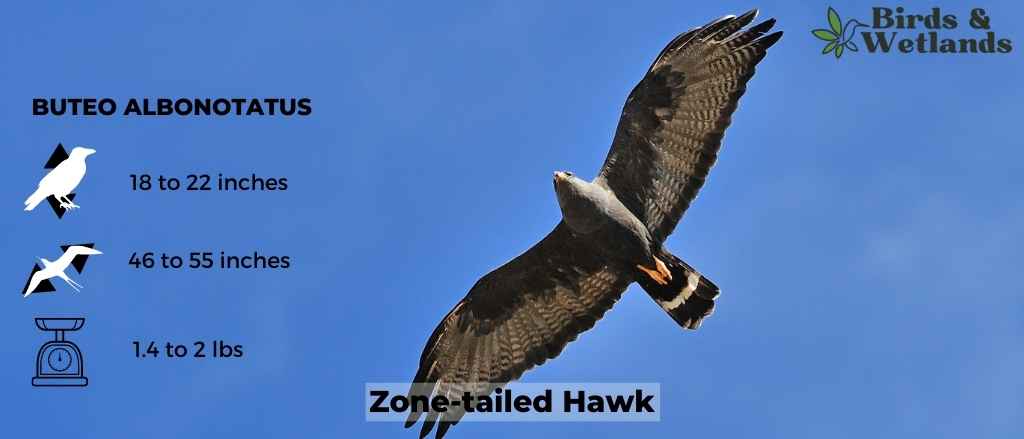

Zone-tailed Hawk Sound
Scientific Name: Buteo albonotatus
Length: 18 to 22 in
Wingspan: 46 to 55 in
Weight: 1.2 to 2 lb
The Zone-tailed Hawk, or Buteo albonotatus, is a medium-sized bird of prey known for its unique appearance and behavior that mimics turkey vultures, a strategy used to deceive prey. This raptor is primarily found in the warmer regions of the Americas, including the southwestern United States, Mexico, and down to Argentina.
The Zone-tailed Hawks body are predominantly black, with white bands, or “zones,” on the tail, which give the bird its name. From a distance, the Zone-tailed Hawk can easily be mistaken for a turkey vulture due to its similar coloration and flight pattern.
Zone-tailed Hawk feeds on small mammals, birds, and reptiles. Its hunting strategy is particularly clever. By mimicking the less-threatening turkey vulture in flight, it can often approach prey unnoticed before launching a surprise attack.
Nesting typically takes place in trees, cliffs, or even on man-made structures. The female lays 1 to 3 eggs, and both parents share incubation and feeding duties.
Where to Spot Hawks in Oregon
Bald Hill Farm, Corvallis: This conservation area is a great location to see Red-tailed Hawks and Cooper’s Hawks. The vast grasslands and nearby forest provide a rich hunting ground for these raptors.
Steens Mountain: The mountain’s high elevation creates ideal wind conditions for migrating raptors, making it a prime spot for hawk watching. This is one of the few places in Oregon where you might spot the rare Ferruginous Hawk.
Klamath Basin National Wildlife Refuges: The refuges are important staging areas for migrating raptors. The vast wetlands attract Northern Harriers, while the open grasslands are hunting grounds for Swainson’s Hawks.
Cape Blanco State Park: Located on Oregon’s southern coast, this park offers a unique opportunity to see coastal raptor migration, including Red-shouldered Hawks and Broad-winged Hawks.
Exploring the hawk diversity in Oregon provides an exciting glimpse into the state’s rich birdlife. Venturing into neighboring states opens new vistas for hawk-watchers, offering a broader perspective on raptor migration patterns and habitats across the Pacific Northwest.
| Neighbouring State’s Hawks | Hawk Watching Site |
|---|---|
| Hawk Species in Washington | Chelan Ridge Hawk Watch |
| Hawk Species in Idaho | Boise Ridge Hawk Watch |
| Hawk Species in Nevada | Goshute Mountains Hawk Watch |
| Hawk Species in California | Golden Gate Raptor Observatory |

